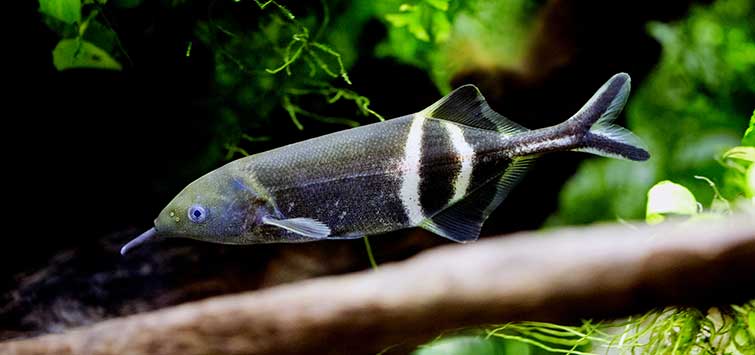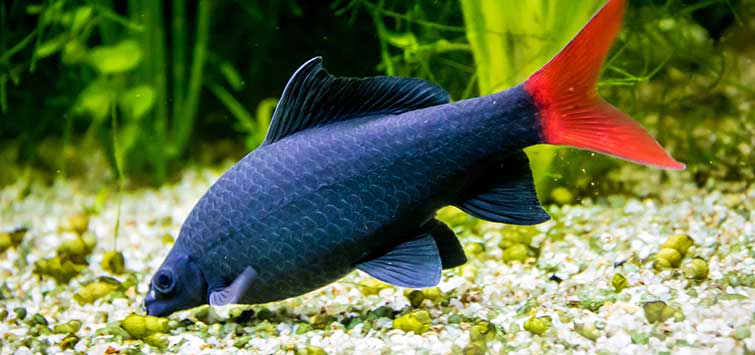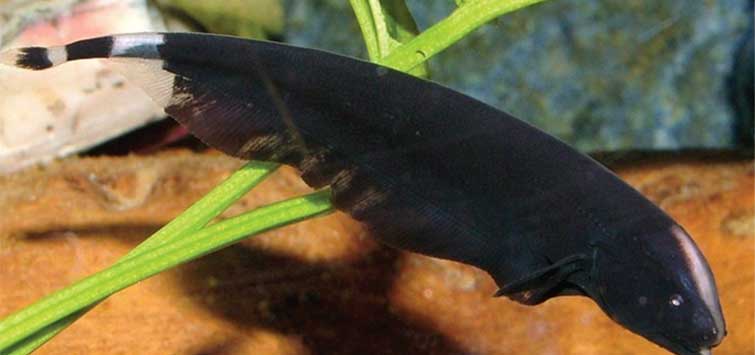Electrical Fishes: Putting a Spark Into Fishkeeping
Author: Chris Sergeant
Finding your way around murky freshwater rivers and lakes is no mean feat, even for a fish. With visibility close to zero, locating food while trying to avoid becoming prey yourself is a gauntlet that numerous species have to run on a daily basis.
However, some fish have adapted to thrive in these conditions. Electrical fishes are adept at adaptation, being capable of hunting, navigating, and communicating within difficult environments.
Electrical Fish Basics
In terms of understanding the electrical fish, we’ve barely scratched the surface. Numerous new species have recently been described, such as the Amazon knifefish Brachyhypopomus bennetti and B. walteri; the knifefish Akawaio penak in Guyana; and, in the Congo River, the mormyrids Petrocephalus boboto and P. arnegardi. Even new genera are being described: Procerusternarchus pixunain, a recently discovered species of bluntnose knifefish from the Rio Negro, is a new genus and species. There are more than 500 known freshwater and marine species of electrical fish.
Bioelectric Fields
Electrical fishes, which can be either electrogenic or electroreceptive, are able to generate their own bioelectric fields using a specialized electric organ, made up of modified nerve or muscle cells. Electroreceptive fishes are species that can detect the electrical fields given off by other animals but cannot produce their own. For example, sharks possess specialized sensory organs called ampullae of lorenzini, which pick up electrical signals produced by muscle contractions in prey species but cannot produce their own electrical field.
Electric Eels
The thought of an electrical fish often conjures the image of the most infamous species, the electric eel (Electrophorus electricus), which uses its short, powerful shocks to incapacitate its prey. Despite its common name, the electric eel is not a true eel but instead a species of knifefish with electric organs. These organs—the main, Hunter’s, and Sach’s organs—run four-fifths of the length of its body. Within these electric organs are specialized cells known as electrocytes, which fire simultaneously when the eel is under threat or when it is attacking prey.
It is this large quantity of electrocytes present in the electric eel that enables the animal to produce short shocks of up to 600 volts. Not all electrical species, however, use their capabilities for stunning their prey. Weakly electrical species produce discharges of less than a volt, which are used to navigate and communicate within their underwater world.
Apteronotidae
Apteronotidae are known as ghost or speckled knifefish and are found in freshwater environments throughout South America. They get their name from the South American native belief that the ghost of the recently deceased takes up residence with these fish. Unlike the electric eel, ghost knifefish produce a wave-like electric organ discharge (EOD), which they use for navigation and electrolocation. By emitting a constant stream of EODs, the ghost knifefish can sense the presence of nearby objects and structures by using its electroreceptors to detect variations in the amplitude and timing of the electric fields.
Black Ghost Knifefish
Physical Characteristics
The most commonly occurring species is the black ghost knifefish (Apteronotus albifrons). This species has an elongated and laterally compressed body, with a large anal fin running from the base of the pectoral fins along almost the rest of the length of its body. Like most other electroreceptive species, knifefish are most effective at sensing the electrical signals around them when their body is rigid.
As a result, electrical species use expanded dorsal or ventral/anal fins for locomotion. So effective is this long anal fin at propelling the knifefish, both horizontally and vertically, in the water column that concept robots using this swimming stance have been developed to try to provide greater control to submersible vehicles.
The black ghost knifefish is a distinctive-looking fish with a jet-black body and fins, bearing two white bands at the base of the tail fin and a white stripe that goes down the back of the head. They also have a large caudal peduncle, which houses the electric organ that emits the continuous EODs.
EODs
The EODs of these nocturnal fish enable them to navigate and negotiate underwater objects in the gloom while hunting their prey. The baseline EOD frequency is usually constant, but it can vary in the presence of conspecifics (members of the same species). Such changes in response to social interactions are termed frequency modulations.
In some cases, female black ghost knifefish will generate EODs at a higher frequency than that of the male, which may allow for sex recognition. Black ghost knifefish deploy a jamming avoidance response to prevent EODs between individuals from overlapping, causing a sensory overload. When two individuals meet, they shift their frequencies until normal electrolocation can occur. Studies have also shown that black ghost knifefish display submissive signals when communicating, with sub-dominant individuals increasing the frequency of their EODs in the presence of a dominant individual.
Size
Black ghost knifefish are a large species, with adults exceeding a foot (30 cm) in length. When kept in an aquarium, full-grown individuals require a tank in excess of 130 gallons (490 liters), while smaller individuals less than 10 inches (25 cm) in length can be housed in a 55-gallon (208-liter) tank.
Lighting
As they are nocturnal, black ghost knifefish appreciate a dimly lit aquarium with floating plants to help reduce the glare from lights and plenty of caves and sunken wood in which to hide. A clear plastic tube can be used to enable the aquarist to observe the knifefish. The knifefish’s electrolocation senses that it is surrounded by a solid object while the animal is still in full view.
Water Conditions
In terms of water conditions, black ghost knifefish are sensitive to parameter fluctuations and do best in Amazonian-like conditions. A softwater setup with a pH that is neutral to slightly acidic should be provided, with a constant temperature range of 75° to 80°F (24° to 27°C) and no ammonia or nitrites present.
On the Market
Recently, captive-raised individuals have started appearing on the market. These fish tend to be much smaller than their wild-caught cousins and may command a higher price. However, these fish adapt to captivity far better than wild-caught fish do and eliminate any pressure on wild populations. They’re also generally in far better condition and health than wild-caught fish.
Feeding
Black ghost knifefish, like all knifefish, are carnivores. Wild fish will often require live foods in the aquarium. Their smaller mouth means that such foods as blackworms, ghost shrimp, and brine shrimp should make up the bulk of their diet. They will quickly learn to appreciate frozen foods, and even pellets will soon be taken eagerly.
As they grow, they will eat small fish, which should be a consideration when choosing tankmates. Captive-raised individuals will generally eat meaty pellets, but supplementing the diet with frozen foods is always recommended.
Brown Ghost Knifefish
Physical Characteristics
The brown ghost knifefish (A. leptorhynchus) is a smaller species of ghost knifefish, typically reaching lengths of 8 inches (20 cm) in the home aquarium. Unlike the black ghost knifefish, the male brown ghost knifefish discharges its electric organ at a higher rate than that of the female, again using EODs to hunt and navigate.
Tankmates
While aggressive with other Apteronotidae species, the brown ghost knifefish is a peaceful fish on the whole and will happily co-exist with tankmates large enough to avoid being swallowed. Care should be taken not to house this, or any other ghost knife, with nippy fish. Its long tail is often irresistible, and knifefish are not able to swim fast enough to avoid being nipped, especially in an aquarium. Eartheaters (Geophagus and related species), other relatively peaceful cichlids, larger tetras, and peaceful catfish species make ideal companions.
Other Knifefish
Duck-Billed Knifefish
On occasion, lesser-known species of knifefish, such as the duck-billed knifefish (Compsaraia samueli) become available. This remarkable species dwells deep down in the Amazonian waters and has a pale, translucent body with small eyes. The males have a larger snout, which they use to fight in a manner similar to fencing, so only one male should ever be kept per tank. This species was described only in 2009, and although sporadically available within the trade, their conservation status and specific requirements are as yet unknown.
Sternopygidae and Notopteridae
Knifefish from the Sternopygidae and Notopteridae families appear less frequently. Sternopygidae, often referred to as glass, or rattail, knifefish, inhabit streams and rivers within South America. The likely species an aquarist will encounter is glass, or green, knifefish (Eigenmannia virescens). Like the black ghost knifefish, this species is shy and nocturnal, preferring to hide among the plants, bogwood, or tubing provided. They are social creatures that do best in a group of five or more, forming a hierarchy of dominant and submissive individuals.
African Knifefish and Clown Knifefish
Notopteridae species include the African knifefish (Xenomystus nigri) and the giant clown knifefish (Chitala ornata). The African knifefish is one of the hardiest species to keep and will occasionally emit a barklike noise when ejecting water from its swim bladder. Growing to approximately one foot (30 cm), it is an appropriately sized species to keep in a home aquarium.
Clown knifefish, on the other hand, can reach sizes of up to approximately 3 feet (one meter) in length, requiring tanks in excess of 185 gallons (700 liters) to adequately house them. These larger knifefish will require larger-sized foods in the aquarium and will certainly eat smaller fish. Large pellets, frozen shrimp, and large-ingredient frozen foods make great dietary options.
Peter’s Elephantnose Fish
Another commonly encountered, weakly electrical fish is Peter’s elephantnose fish (Gnathonemus petersii) from the Mormyridae family hailing from Central and West Africa. The fish gets its name from the trunklike projection on the front of its head, although this is actually an extension of its mouth, as opposed to the nose on an elephant. Like all mormyrids, Peter’s elephantnose fish use EOD during electrolocation and electrocommunication.
Electric Aura
A recent study by Philine Feulner at the University of Sheffield, in England, has shown that male elephantnose fish lure females with the aid of an electric field. With numerous closely related species living together in murky waters, finding a mate can be difficult. The research shows that females can locate and select males of their own kind based on their “electric aura,” as opposed to males of other similar species. This electrical attraction helps to preserve the genetic differences between near-identical species and shows that elephantnose fish “mate assortatively according to EOD waveform characteristics.”
Big Brains
As a result of their capacity to process electrical signals, Peter’s elephantnose fish have an increased brain mass compared with similar-sized fish species. They have the largest brain-to-body-weight ratio of all known living vertebrates, and up to 60 percent of the fish’s oxygen uptake is used by the brain.
Vision
Like the electric eel and knifefish species, Peter’s elephantnose fish inhabit dimly lit, slow-moving waters. Originally thought to be blind because of the unique structure of their retina, it was later determined that they have excellent low-light vision, enabling them to spot predators in the gloom.
Aquarium Requirements
When keeping these fish in a home aquarium, their housing should reflect these requirements. Peter’s elephantnose fish are timid and nocturnal, so any prospective tank should have reduced lighting, along with plenty of bogwood, rocks, and such low-light vegetation as Java fern or Anubias.
As with knifefish, the addition of a “ghost tube” will provide security while facilitating viewing during daylight hours. A soft, fine substrate should be provided to allow the fish to sift through, hunting for food, without damaging its mouth parts. Elephantnose fish tend to be unfussy eaters, accepting a variety of dried flakes, pellets, frozen foods, and live aquatic invertebrates, with various aquarists reporting success with hand feeding.
In a home aquarium setting, an adult Peter’s elephantnose fish will attain a size of 9 inches (23 cm), so one individual will require a tank that’s around 65 gallons (246 liters). Keeping a group of elephantnose fish will reduce nervous or skittish behavior, with preferably five or more kept together to prevent intraspecific territorialism and consequent bullying.
Tankmates
Although generally considered peaceful, elephantnose fish may be aggressive toward smaller species, so consideration should be taken when introducing tankmates. Other African species such as small birchirs, butterflyfish, and Congo tetras make ideal companions.
Keep Your Tank Looking Sharp
Weakly electrical fish make curious and fascinating additions to suitable-sized aquariums. When kept under the correct conditions, they will reward the aquarist with an array of novel and unique behavioral patterns. If you can meet and maintain the proper environmental parameters, you will be able to sit back and enjoy nature at work.

.png?h=595&iar=0&w=2781&hash=5FD5E69473BCC22199FBFA2FB71B6033)



